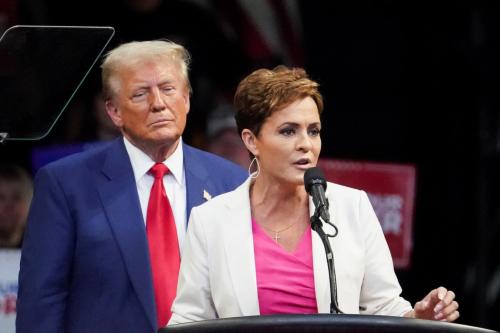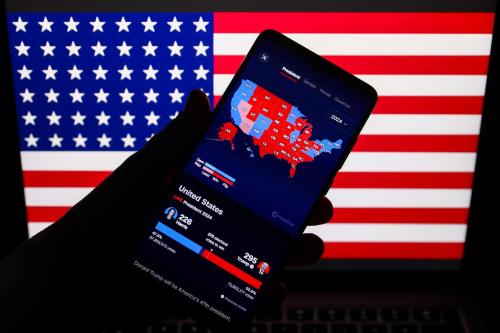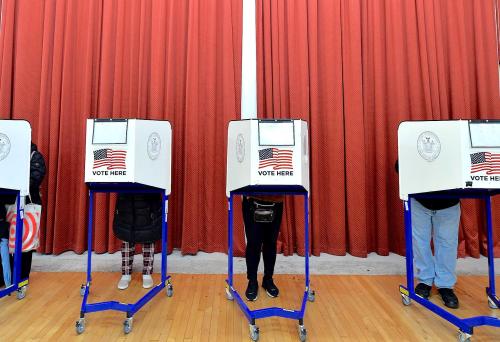If you don’t think ideological perceptions matter in American politics,
you need read no further. If you do and you’re a Democrat, there’s
something to worry about. Even as the terms of the political debate in
Washington, in the eyes of many Democrats, have moved steadily to the
right, the electorate is increasingly likely to see itself as
ideologically closer to the Republican Party than to Democrats. Unless
Obama and Democrats can find a solution to this riddle—and find one
fast—they will be contesting the 2012 election on forbidding terrain.
In mid-2005, as disaffection with the Bush administration and the Republican Party was gathering momentum, the Pew Research Center asked American to place themselves and the political parties on a standard left-right ideological continuum. At that time, average voters saw themselves as just right of center and equidistant from the two political parties. Independents considered themselves twice as far away from the Republican Party as from the Democrats, presaging their sharp shift toward the Democrats in the 2006 mid-term election.
In August of this year, Pew posed a very similar question (note to survey wonks: Pew used a five-point scale, versus six in 2005), but the results were very different. Although average voters continue to see themselves as just right of center, they now place themselves twice as far away from the Democratic Party as from the Republicans. In addition, Independents now see themselves as significantly closer to the Republican Party, reversing their perceptions of six years ago.
There’s another difference as well. In 2005, Republicans’ and Democrats’ views of their own parties dovetailed with the perceptions of the electorate as a whole. Today, while voters as a whole agree with Republicans’ evaluation of their party as conservative, they disagree with Democrats, who on average see their party as moderate rather than liberal. So when Independents, who see themselves as modestly right of center, say that Democrats are too liberal, average Democrats can’t imagine what they’re talking about.
Compounding the problem, the American people are gradually polarizing. According to Gallup, twenty years ago, as Bill Clinton began his presidential campaign, self-described moderates formed the plurality of the electorate—43 percent; conservatives were 36 percent, liberals 17 percent. By the summer of 2011, the conservative share had risen to 41 percent and liberals to 21 percent, while moderates declined to 36 percent, surrendering their plurality status to conservatives. Because nearly all conservatives now vote for Republicans and liberals for Democrats, the share of the shrinking pool of moderates that Democrats need to build a majority is now larger than ever.
Another Gallup finding that should alert Democrats is the ongoing collapse of public confidence in government. A survey released earlier this week found that Americans now believe that the federal government wastes 51 cents of every dollar it spends, the highest estimate ever recorded. Twenty-five years ago, that figure stood at only 38 cents. While estimates of waste at the state and local level remain lower than for the federal level, they have also risen by double digits in recent decades.
Overall, it’s hard to avoid concluding that the ideological playing-field heading into 2012 is tilted against Democrats. This reality only deepens the strategic dilemma the White House now confronts. The conventional strategy for an incumbent is to secure the base before the general public gets fully engaged and then reach out to the swing voters whose decisions spell the difference between victory and defeat. By contrast, the Obama team spent most of 2011 in what turned out to be a failed effort to win over the Independent voters who deserted Democrats in droves last November, in the process alienating substantial portions of the base. To rekindle the allegiance and enthusiasm of core supporters, the president now finds himself having to draw sharp ideological lines, risking further erosion among Independents and even moderate Democrats. Tellingly, a number of at-risk Democratic senators up for reelection in 2012 have already refused to go along with key elements of the president’s recent proposals.
Granted, ideology isn’t everything. Political scientists have long observed that Americans are more liberal on particulars than they are in general—ideologically conservative but operationally liberal. (Surveys have shown majority support for most individual elements of the president’s jobs and budget packages.) And the Republicans could undermine their chances by nominating a presidential candidate who is simply too hard-edged conservative for moderates and Independents to stomach.
In the face of widespread skepticism and disillusion, it will be an uphill battle for Democrats to persuade key voting blocks that government can really make their lives better. But if they fail, the public will continue to equate public spending with waste, the anti-government message will continue to resonate, and Democrats will be in dire straits when heading into what is shaping up as a pivotal election.
The Brookings Institution is committed to quality, independence, and impact.
We are supported by a diverse array of funders. In line with our values and policies, each Brookings publication represents the sole views of its author(s).



Commentary
Op-edLeft Behind: How Democrats Are Losing the Political Center
September 24, 2011